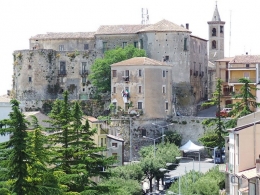Caggiano
Caggiano is a medieval town overlooking the Tanagro Valley, on a 820 m cliff. You can enter the village through four gates: Marvicino, Portuccia, San Luca and Bocca del Ponte, all within the city wall, near which once were several gatehouses.
The Norman castle of Guiscardo
Majestic and imposing example of defensive work (10th-11th centuries). The original structure consisted of a central body, three tall towers joined by a wall, a defensive tower, two forts and two gates: San Luca and Bocca del Ponte. It is called "of the Guiscard", because the works to reinforce the structure’s defence was made by William of Cauciano, belonging to the family of Robert the Guiscard. From the 14th century it became a Manor House. Today part of the castle is a municipal property and it is used for exhibitions and cultural events.
Opening
On Saturdays, Sundays and public holidays : 9,30 – 12,30 AM and 5 – 8 PM
From Tuesday to Friday : 9,30 – 12,30 AM
The ancient medieval road
It has probably been the first road access to the village; it is a steps cobbled street connecting the cultivated fields of the Valley to the village. Along the street you will see the Church of Santa Venere and the caves once used by Orthodox monks for meditation.
Church of Santissimo Salvatore
In the town centre’s heart, next to the Town Hall, it has been establishes one of the early Latin worship Churches, the Church of Santissimo Salvatore. Parish church of Caggiano, dating back to the 12th century, it has a single nave, presbytery and vaulted; the ceiling was once a canvas painted coffered ceiling.
Saint Mary of Greek
The Church of Santa Maria dei Greci dates back, according to local tradition, to the mid-6th century, enough to be considered the first Church in the town; its original Greek-cross plan testifies the belonging to Basilian monks and the Orthodox worship, until 1770 when, instead, latin worship was officated (and the plant was restored according to a Latin cross). Inside are kept nine Peccheneda's works, including the celebrated "Our Lady of Mount Carmel with angels and damned people", in addition to the marble Altar and a wooden altar dedicated to Saint Bartholomew. On the left outer wall, according to the legend, there is the Holy stone brought by the Templars from Palestine.
Saint Catherine’s Church
It dates back to the 11th century and was dedicated to the Greek Orthodox worship, as confirmed by the Greek-cross plan. It was damaged by the earthquake of 1857, and partially restored in the early 20th century, when it has been enriched with frescoes on the vault of the presbytery. Inside it keeps several works by Nicola Peccheneda dating back to 1700s.
Saint Venus’s Church
The Church of Santa Venere, also known as Cappella di Santa Veneranda or also Santa Sophia Church, probably dates to the 11th century. With a single nave and a semicircular apse, it represents one of the earliest examples, in the area, of religious structure in Greek-Byzantine style. It is located outside the city wall, on top of a rocky outcrop, and is visible from the Valley and the belvedere of Portuccia and Marvicino. Its building was almost certainly due to the presence of Basilian monks who, after abandoning the caves in which they were originally refugees from the Saracens, realized, with the help of the local community, their places of worship.
Saint Agatha’s Church
On Sant’ Agata hill lie the remains of a Templar mansion dating back to the 13th century. It housed a single nave church dedicated to Saint Agatha, dating from the 12th century. In 1312 it passed to the Knights Hospitaller.
Saint Luke’s Chapel
Saint Luca Chapel, built in the 13th century, has a single nave and was formerly the guardhouse; until 1864 it has also been equipped with a nearby hospital where, in addition to medical care and Hospice for pilgrims, it was customary to distribute free medicines to the poor people.



 Sito web:
Sito web: 





